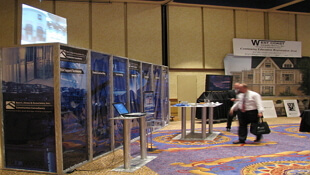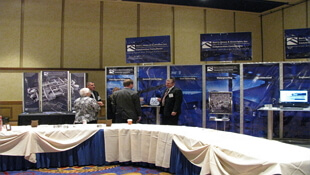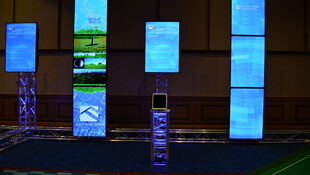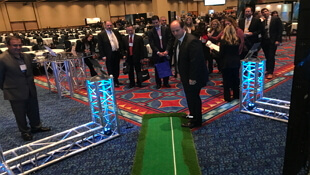20 Years of BHA at West Coast Casualty's CD Seminar: Chronicling BHA's Innovative Exhibits
May 03, 2018 —
Beverley BevenFlorez-CDJ STAFFThe Bert L. Howe & Associates, Inc., (BHA) exhibit has been a fixture at West Coast Casualty's Construction Defect Seminar since the mid-1990's. Through the years, BHA has updated their display, but no matter what year, you could count on the BHA exhibit to provide a not-to-be-missed experience.
2008-BHA's sleek, rear projection display includes a screen that promotes the firm's capabilities that can be seen throughout the exhibit hall. This would be one of many innovations BHA has brought to the West Coast Casualty seminar.

2009-With the success of the rear screen projection, BHA adds additional monitors to provide attendees with more information about BHA.

2010-BHA adds an interpretive professional development exhibit targeted to Building Envelope issues allowing adjusters and other non-construction professionals hands on access to the systems and components at the heart of many related such claims.



2011-BHA's Swing for Charity challenge is born.

2012-Always innovating, BHA expands its rear projection and professional development offerings to West Coast attendees.

2013-BHA showcases additional capabilities with a twenty-four foot, custom, convex, immersive video experience.

2014-BHA adds an iPhone display to give a hands-on demonstration of their data collection methods.

2015-BHA's twenty-four foot , custom, convex, immersive video experience was elevated with two additional rear projection screens, reflecting BHA's newest capabilities and services.

2016-BHA dazzles attendees with their new exhibit comprised of more than 15 integrated, high definition, LCD displays. iPads are stationed on tables to conveniently demonstrate BHA's data collection processes.

2017-BHA's Swing for Charity Golf Challenge raised $2,225.00 for the National Coalition for Homeless Veterans and $1,900 for Final Salute.


Read the court decisionRead the full story...Reprinted courtesy of
Differing Rulings On Construction Defect Claims Leave Unanswered Questions For Builders, and Construction Practice Groups. Impact to CGL Carriers, General Contractors, Builders Remains Unclear
March 07, 2011 —
CDJ STAFFIn the past year a number of state and federal courts have rendered a number of conflicting decisions that promise to alter or perhaps shift entirely the paradigm, of how builders manage risk.
�According to a report today by Dave Lenckus in Property Casualty 360 “Nine state and federal courts and one state legislature over the past year have addressed whether a construction defect a defective product or faulty workmanship is fortuitous and therefore an occurrence under the commercial general liability insurance policy. Four jurisdictions determined it is; three said no; two ruled that a construction defect that causes consequential damage to property other than the work product is an occurrence; and one federal court contributed its conflicting case law that has developed in Oregon since its high court ruled in 2000 that a construction defect is not an occurrence”.
�The article strongly suggests that in the absence of a clear consensus over what the recent rulings mean for builders and contractors coverage disputes will intensify and continue to proliferate.
� Doing this on a state-by-state basis has caused a lot of confusion among buyers and sellers, said Jeffrey A. Segall, a Tampa-based senior vice president and the Florida Construction Practice leader at Willis of Florida, a unit of Willis Group Holdings.
�Read Full Story...
Read the court decisionRead the full story...Reprinted courtesy of
Fourth Circuit Issues New Ruling on Point Sources Under the CWA
October 02, 2018 —
Anthony B. Cavender - Gravel2GavelThe Clean Water Act (CWA) authorizes citizen suits to enforce the provisions of the law which requires a permit to discharge a pollutant from a point source into navigable waters. Earlier this year, the U.S. Court of Appeals for the Fourth Circuit, in Upstate Forever v. Kinder Morgan Energy Partners, held that discharges into groundwater, not surface water, could also trigger the regulatory authority of the CWA if there was a hydrological connection between the groundwater and the navigable, surface, waters. In its a closely-watched case, Sierra Club v. Virginia Electric & Power Company (“VEPCO”), which also involved discharges into groundwater, the Fourth Circuit was bound by this this new and controversial precedent (a Supreme Court review is very likely), but the plaintiffs in the VEPCO case could not establish that the landfill and the settling ponds used by VEPCO were “point sources”—another important element that must be established.
Read the court decisionRead the full story...Reprinted courtesy of
Anthony B. Cavender, PillsburyMr. Cavender may be contacted at
anthony.cavender@pillsburylaw.com
California Supreme Court Finds Vertical Exhaustion Applies to First-Level Excess Policies
August 26, 2024 —
Tred R. Eyerly - Insurance Law HawaiiAddressing issues left open in its seminal decision in Montrose, the California Supreme Court found that the language in the first-level excess policies meant that the insured could access the policies upon exhaustion of the directly underlying policies purchased for the same policy period. Truck Ins. Exchange v. Kaiser Cement & Gypsum Corp., 2024 Cal. LEXIS 3271 (Cal. June 17, 2024).
From 1944 through the 1970's, Kaiser manufactured asbestos-containing products at numerous different facilities. By 2004, more than 24,000 claimants had filed product liability claims against Kaiser alleging that they had suffered bodily injury as a result of exposure to Kaiser's asbestos products. Kaiser tendered these claims to Truck, one of several primary insurers that had issued CGL policies to Kaiser.
In 2001, Truck initiated this coverage action to determine its indemnity and defense obligations to Kaiser. Truck later amended its complaint to add a cause of action for contribution against several of Kaiser's excess insurers. The issue presently before the court was whether Truck was entitled to contribution from various coinsurers that issued first-level excess policies to Kaiser during the period in question.
Read the court decisionRead the full story...Reprinted courtesy of
Tred R. Eyerly, Damon Key Leong Kupchak HastertMr. Eyerly may be contacted at
te@hawaiilawyer.com
Privacy In Pandemic: Senators Announce Covid-19 Data Privacy Bill
May 11, 2020 —
Kyle Janecek & Jeffrey Dennis – Newmeyer Dillion"Data! Data! Data!. . . I can't make bricks without clay." This classic statement from Sherlock Holmes in The Adventure of the Copper Beeches takes on a new meaning in the COVID-19 pandemic. With the plans to begin contact tracing the spread of the COVID-19 pandemic slowly moving towards the forefront, a valid and important issue presents itself: how do we treat and protect the data we so desperately need to trace, track, and address the pandemic? U.S. Senators Wicker, Thune, Moran, and Blackburn introduced a possible solution to this problem with the COVID-19 Consumer Data Protection Act, as announced on April 30, 2020. So what does the Act entail? What information is protected? What action would businesses need to take towards individuals, such as consumers or even employees, in order to comply with this new legislation?
WHAT IS THE COVID-19 CONSUMER DATA PROTECTION ACT?
The Act is meant to address the concern regarding data collection and privacy due to large companies, like Google and Apple, adjusting the software within their devices to facilitate digital contact tracing. The Act can be broken up into three parts - the treatment of information; the privacy notice requirements; and the transparency requirements.
First, the Act prohibits the collection, processing, or transfer of certain categories of data without notice and the affirmative express consent of the individual, in order to:
- Track the spread of COVID-19,
- Trace the spread of COVID-19 through contact tracing, or
- Determine compliance with social distancing guidelines without the requisite notice to individuals and their express consent.
To accomplish this, the Act also restricts entities in their ability to collect excessive information, stating that an entity cannot collect information beyond what is reasonably necessary to conduct any of the three COVID-19 related purposes listed in the statute. The entity must also provide reasonable administrative, technical, and physical data security policies and practices to protect the information collected. Furthermore, in the event that the entity stops using the information for any of the three COVID-19 purposes, it must delete or de-identify the information it has collected.
Next, the Act describes the requirements for notice to individuals. In order to legally collect, process or transfer the information, the entity needs to provide the consumer with prior notice of the purpose, processing, and transfer of the data through their privacy policy within 14 days of the enactment of the law. This policy would have to:
- Disclose the consumer's rights in a clear and conspicuous manner prior to or at the point of collection,
- Be available in a clear and conspicuous manner to the public,
- Include whether the entity will transfer any of the information it collects in order to track or trace COVID-19 or determine compliance with social distancing,
- Describe its data retention policy, and
- Generally describe its data security measures.
Notably, many of these are already requirements common to many privacy policies, including the disclosure regarding the transfer of an individual's information.
In addition, an individual must give their affirmative express consent to such collection, processing and transfer. In other words, an individual must "opt-in" to having their information collected. This would be done through a checked box or electronic signature, as the law prohibits entities from inferring consent through a failure by the individual to take an action stopping the collection. Furthermore, the individual would also need the ability to expressly withdraw their consent, with the entity then having to cease collection, processing, or transfer of the information within 14 days of the revocation. In essence, due to the restriction on transferal, this may result in businesses opting to delete or de-identify data upon a revocation.
Finally, the entity would have to abide by certain reporting and transparency requirements, namely a monthly public report stating how many individuals had information collected, processed or transferred, and describing the categories of the data collected, processed or transferred by the entity and why. This is akin to the California Consumer Privacy Act's treatment of categories of information, though it would require this information to be released on an ongoing, monthly basis.
WHAT DATA IS COVERED?
Notably, the Act only affects a very limited scope of data. The Act covers geolocation data (exact real-time locations), proximity data (approximated location data), and Personal Health Information (any genetic/diagnosis information that can identify someone). This could cover information like Bluetooth communication or real-time tracking based on a cell phone's geolocation features. Notably, Personal Health Information does not include any information that may be covered under HIPAA or the broader categorization of "Biometric" data (i.e. retinal scans, finger prints, etc). Furthermore, and more generally, "publicly available information" is excluded, which includes information from telephone books or online directories, the news media, "video, internet, or audio content" as well as "websites available to the general public on an unrestricted basis." The latter of which potentially would push any and all information made available through social media (i.e. Facebook or Twitter) into the definition of "publicly available information."
HOW IS IT ENFORCED?
Generally, the law would be enforced by the FTC, under the provisions regarding unfair or deceptive acts or practices, similar to other enforcement actions arising out of privacy policies. Notwithstanding, state attorney generals may also bring actions to enforce compliance and obtain damages, civil penalties, restitution, or other compensation on behalf of the residents of the state.
WHAT SHOULD MY COMPANY DO?
If your entity plans on collecting information for tracking COVID-19, measuring social distancing compliance, or contact tracing, it is advisable to include language in your privacy policy now. This could be as simple as adding an additional provision within your privacy policy stating that the entity will retain information to conduct one of the three COVID-19 purposes as laid out in the statute. In addition, this also means that should the entity collect and use employee information for contact tracing, tracking the spread of COVID-19 or ensuring compliance with social distancing measures, it will need to disclose some of the specifics of that process to the employees and have them opt-in for the process. Finally, for contact tracing purposes, any individual that shares their diagnosis will have to opt-in for the entity to legally collect, process, and transfer that information to others.
While the time to reach compliance is unknown, it is more important than ever to form a compliance plan for privacy legislation if you do not already have a plan in place. If you decide to prepare with us, our firm has created a 90 day California Consumer Privacy Act compliance program (which can be expedited) where our team will collaborate with you to determine a scalable, practical, and reasonable way for you to meet your needs, and we will provide a free initial consultation. For further inquiries or questions related to COVID-19, you can consult with a Task Force attorney by emailing NDCovid19Response@ndlf.com or contacting our office directly at 949-854-7000.
Kyle Janecek is an associate in the firm's Privacy & Data Security practice, and supports the team in advising clients on cyber related matters, including policies and procedures that can protect their day-to-day operations. For more information on how Kyle can help, contact him at kyle.janecek@ndlf.com.
Jeff Dennis (CIPP/US) is the Head of the firm's Privacy & Data Security practice. Jeff works with the firm's clients on cyber-related issues, including contractual and insurance opportunities to lessen their risk. For more information on how Jeff can help, contact him at jeff.dennis@ndlf.com.
Read the court decisionRead the full story...Reprinted courtesy of
Measure of Damages in Negligent Procurement of Surety Bonds / Insurance
September 04, 2018 —
David Adelstein - Florida Construction Legal UpdatesMy broker procured the wrong insurance and I am exposed to a loss. My broker failed to procure proper insurance and I am exposed to a loss. “Where the parties enter into an agreement to procure insurance and there is a negligent failure to do so, an insurance broker may be liable for damages.” The Lexington Club Community Association, Inc. v. Love Madison, Inc., 43 Fla.L.Weekly D1860a (Fla. 4th DCA 2018). The proper measure of damages in a negligent procurement of insurance claim is “what would have been covered had the insurance been properly obtained.” Id. quoting Gelsomino v. ACE Am. Ins. Co., 207 So.3d 288, 292 (Fla. 4th DCA 2016). This measure of damages in a negligent procurement of insurance claim is important because it is the measure of damages that dictates recoverable damages under this claim.
Read the court decisionRead the full story...Reprinted courtesy of
David Adelstein, Kirwin NorrisMr. Adelstein may be contacted at
dma@kirwinnorris.com
Hunton Partner Michael Levine Appointed to Law360’s 2024 Insurance Authority Property Editorial Advisory Board
May 20, 2024 —
Hunton Insurance Recovery BlogWashington, DC-based partner
Michael Levine has been recognized for his extensive experience and insights into emerging and legacy property and business interruption insurance coverage issues by being selected to Law360’s 2024 Editorial Advisory Board for Insurance Authority Property. As a member of the board, Mike will provide feedback on Law360’s coverage of property issues and expert insight on how best to shape future reporting of issues affecting businesses across all industry sectors.
Reprinted courtesy of
Hunton Andrews Kurth llp
Read the full story... Read the court decisionRead the full story...Reprinted courtesy of
New York Building Boom Spurs Corruption Probe After Death
August 19, 2015 —
Chris Dolmetsch & David M. Levitt – BloombergNew York’s building boom has spurred the formation of a task force to probe corruption in the construction industry.
The group of prosecutors and inspectors plan to go after companies that ignore or hide safety violations or commit other crimes including bid rigging and extortion.
The formation of the task force was announced the same day two men and their companies were indicted for causing a worker’s death in April by failing to address repeated warnings about safety at a construction site in Manhattan’s Meatpacking District.
Reprinted courtesy of
Chris Dolmetsch, Bloomberg and
David M. Levitt, Bloomberg
Read the court decisionRead the full story...Reprinted courtesy of




































































